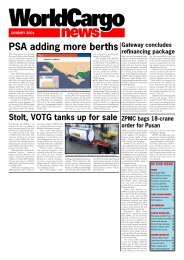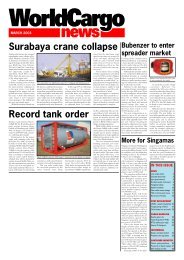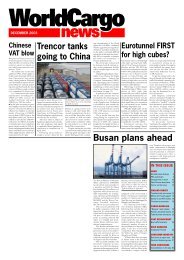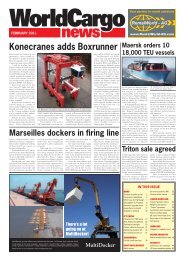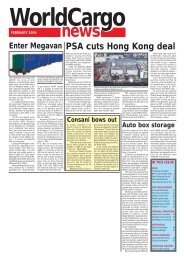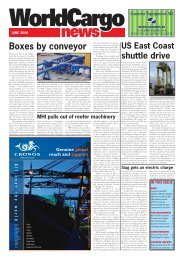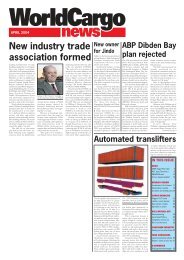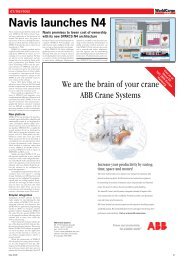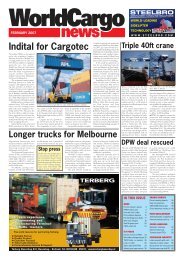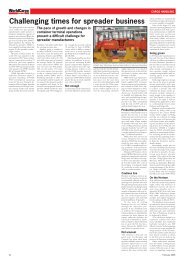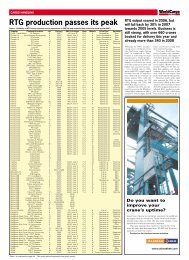Tanjung Priok super port - WorldCargo News Online
Tanjung Priok super port - WorldCargo News Online
Tanjung Priok super port - WorldCargo News Online
Create successful ePaper yourself
Turn your PDF publications into a flip-book with our unique Google optimized e-Paper software.
CARGO HANDLING<br />
Braking cranes on the run<br />
In 2011 the Japanese Association<br />
for Cargo Handling Machinery<br />
Systems, in operation with the<br />
Ministry of Land, Infrastructure<br />
and Trans<strong>port</strong>, Omaezaki Port and<br />
Shizuoka Prefectural Office conducted<br />
an experiment with dynamic<br />
rail clamps. As a result, dynamic<br />
rail clamps are now recommended<br />
for all Japanese <strong>port</strong>s.<br />
Not everyone in the braking<br />
industry agrees that rail clamps<br />
that act on the top of the crane<br />
rail are a good option for a dynamic<br />
storm brake. Several manufactures<br />
believe they are a holding<br />
brake only, and cranes should<br />
be equipped with wheel brakes to<br />
stop the crane in the long travel<br />
distance. However, many cranes<br />
are fitted with rail clamps with<br />
brake pads (rather than serrated<br />
shoes) to provide dynamic braking<br />
in an E-stop situation.<br />
Blown away<br />
In January 2010 a crane in the Port<br />
of Omaezaki was blown along the<br />
rail by wind. The <strong>port</strong> and the organisations<br />
listed above began a<br />
study to try and determine,<br />
amongst other things, whether rail<br />
clamps can effectively stop a crane<br />
in motion, and a realistic coefficient<br />
of friction (CoF) to use<br />
when specifying rail clamps<br />
(known as “rail brakes” in Japan).<br />
The biggest problem with rail<br />
clamps is that the crane rail is the<br />
braking surface. It can be wet,<br />
greasy from hydraulic oil and<br />
other contaminants, warped and<br />
uneven. To test some of these factors,<br />
Omaezaki used a crane on<br />
its west wharf fitted with a rail<br />
clamp with a pressing force of 500<br />
kN on top of the rail, generating<br />
a braking force of around 300 kN<br />
with a maximum stroke of 10mm.<br />
Two sets of brake pads were<br />
used: one measured 290 x 125mm<br />
In an effort to prevent crane<br />
runaways, dynamic rail clamps are<br />
now recommended in Japan<br />
and the other was half that size.<br />
The linings were a metal-based<br />
synthetic resin material.<br />
The dynamic CoF of the brake<br />
was calculated in a series of experiments<br />
where the crane was accelerated<br />
to a predetermined<br />
speed and the emergency stop<br />
button was then pressed. Tests were<br />
repeated over several months to<br />
assess the impact of wear of the<br />
brake pads, in dry and wet conditions<br />
and on a greasy rail.<br />
Wide variations<br />
The first results were quite random,<br />
with dynamic CoFs varying<br />
between 0.1 and 0.4. It made little<br />
difference whether the rail was<br />
wet or dry. Grease and oils, however<br />
dramatically cut the dynamic<br />
CoF to around 0.1, and once the<br />
pads were contaminated this could<br />
not be improved by cleaning.<br />
Further investigation revealed<br />
that the biggest factor affecting<br />
performance was the state of the<br />
crane rail and the clearance between<br />
the rail and brake pad.<br />
When the test was repeated on<br />
another section of crane rail where<br />
the clearance did not exceed the<br />
specifications of the clamp, the<br />
results were much more consistent,<br />
with dynamic CoF values in<br />
the range of 0.22 to 0.36 on wet<br />
and dry rails. Doubling the size of<br />
the brake pad had little effect.<br />
The study concluded that dynamic<br />
rail clamps are able to stop<br />
cranes in a reliable, predictable<br />
manner, but there is a need for rail<br />
clamps that have more stroke tolerance<br />
to accommodate uneven<br />
crane rails. Masharahu Sinohara,<br />
executive officer for engineering<br />
and planning at Osaka Port remarked<br />
that although rail clamps<br />
are not mandatory, they are now<br />
recommended and most new STS<br />
cranes in Japan have them.<br />
Long travel target<br />
In other developments, Chinese<br />
brake manufacturer Jiangxi<br />
Huawu Brake Company has made<br />
developing electromagnetic multidisc<br />
brakes and wheel brakes for<br />
gantry long travel applications a<br />
research priority. In recent years<br />
Huawu has focused on brakes for<br />
wind turbines and it achieved sales<br />
of Yuan50M in this market in<br />
2012. It is now targeting other<br />
industrial applications where im<strong>port</strong>ed<br />
products still dominate the<br />
domestic Chinese market, working<br />
with universities and the<br />
Jiangxi Provincial Science and<br />
Technology Department to develop<br />
new products.<br />
As far as growing its ex<strong>port</strong><br />
business is concerned, Huawu recently<br />
stated its intention to “continue<br />
to intensify efforts to develop<br />
the international market.” It<br />
will try to leverage ZPMC’s overseas<br />
spare parts network to build<br />
a sales channel into overseas markets,<br />
but is also building an “international<br />
marketing team” to<br />
promote cooperation with foreign<br />
companies.<br />
Römer into Asia<br />
Germany-based manufacturer of<br />
brakes and other components<br />
Römer Fördertechnik GmbH has<br />
signed an exclusive representation<br />
agreement with Singapore-based<br />
Portek. Portek, which previously<br />
worked with Ican, will be Römer’s<br />
sole representative in the following<br />
markets: Singapore, Indonesia,<br />
Malaysia, Vietnam, Philippines,<br />
Thailand, Laos, Myanmar, Brunei,<br />
Cambodia and Hong Kong. The<br />
agreement also covers countries<br />
where Portek is operating terminals<br />
- currently Algeria, Gabon,<br />
Malta, Rwanda and Latvia.<br />
In its brake product line<br />
Römer has developed a new<br />
thruster called the Turbo brake lifting<br />
system (TBLS) that reduces<br />
the brake actuation time from<br />
350-450 millisecs to 150 millisecs.<br />
Römer builds its own thrusters<br />
under the RBL (Römer Brems-<br />
Lüftgeräte) brand. Depending on<br />
the load, said the company, the<br />
apply time of a regular hydraulic<br />
thruster according to DIN 15430<br />
amounts to ca. 300-500 millisecs.<br />
By a special control of the pump<br />
motor, this apply time is reduced<br />
to about 150 millisecs, independent<br />
of the load (even in case of a<br />
power failure) with integrated uninterrupted<br />
power supply.<br />
The control system reduces the<br />
inrush current and the thermal<br />
load on the motor, which Römer<br />
says will improve service life significantly.<br />
The TBLS can be used<br />
with drum, disk and band brakes.<br />
Römer is making a concerted<br />
push into <strong>port</strong>s and has supplied<br />
crane OEMs including Hans<br />
Kuenz, Konecranes, Terex, KSR<br />
Germany (part of Kranunion) and<br />
Paceco España. It is also targeting<br />
storm brakes, where it claims that<br />
many brakes are actually undersized<br />
because they are specified with an<br />
unrealistically high CoF for the application.<br />
Römer is adamant that<br />
the only appropriate value is<br />
µ=0.25 according to DIN 15019,<br />
but says this is frequently exceeded.<br />
As regards other crane components,<br />
Römer has developed a<br />
new buffer system that enables the<br />
piston rod of the buffer to retract<br />
Italy-based RIMA Srl has kept up<br />
a busy stream of business this year,<br />
following a strong 2012. It has received<br />
multiple orders for storm<br />
brakes for container handling<br />
cranes, in particular for automated<br />
stacking cranes (ASCs)<br />
and bulk handling cranes, placed<br />
by OEMs in Germany, India,<br />
China and the Middle East. In<br />
addition, there were im<strong>port</strong>ant orders<br />
for other hydraulic components<br />
including micro-motion control<br />
systems for <strong>port</strong> cranes and offshore<br />
applications.<br />
In the early part of this year<br />
more orders have come in, from<br />
<strong>WorldCargo</strong><br />
news<br />
Römer’s Turbo brake lifting system actuates in just 150 millisecs<br />
when two cranes are working very<br />
closely together, and extend again<br />
when the cranes move apart. This<br />
will be particularly useful on retrofit<br />
applications where space is often<br />
constrained. ❏<br />
RIMA storms forward<br />
OEMs including Mitsubishi<br />
Heavy Industries, Mitsui Engineering<br />
& Shipbuilding, Baltkran<br />
and PHB (in Spain).<br />
Highlight include the orders<br />
from Trans Gulf Port cranes (part<br />
of IMCC) in Abu Dhabi for the<br />
rail clamps and hydraulic trim,<br />
list and skew systems for 10 STS<br />
cranes and the rail brakes for 25<br />
ASCs it is building for DP World,<br />
Jebel Ali Terminal 3.<br />
The 40 ASCs being supplied<br />
by Kalmar to DP World<br />
London Gateway (phase 1) are<br />
also being furnished with<br />
RIMA rail brakes. ❏<br />
RIMA rail clamp on STS container crane in the Far East<br />
STRONG. PINTSCH BUBENZER Emergency Brakes. Made in Germany.<br />
In the sectors of container handling, shipbuilding and offshore<br />
engineering, mining, the steel industry, utilization of wind,<br />
mechanical engineering and construction of special vehicles,<br />
PINTSCH BUBENZER is a world leader in braking system design<br />
and manufacturing, with safety built into every product.<br />
Visit our homepage www.pintschbubenzer.de<br />
May 2013 71



